California regulators approved an expansion that will allow two rival robotaxi services to operate throughout San Francisco at all hours, despite safety worries spurred by recurring problems with unexpected stops and other erratic behavior.
The state’s Public Utilities Commission voted to approve rival services from Cruise and Waymo to operate around-the-clock service. It will make San Francisco first major U.S. city with two fleets of driverless vehicles competing for passengers against ride-hailing and taxi services dependent on humans to operate the cars.
It is a distinction that San Francisco officials didn’t want, largely because of the headaches that Cruise and Waymo have been causing in the city while testing their robotaxis on a restricted basis during the past year.
But it ended in a major victory for Cruise – a subsidiary of General Motors – and Waymo – a spinoff from a secret project at Google – after spending years and billions of dollars honing a technology that they believe will revolutionize transportation. Both companies view approval of their San Francisco expansions as a major springboard to launching similar services in other congested cities that would benefit from a technology that they contend will be more reliable, convenient and cheaper than ride-hailing and taxi services reliant on human drivers.
During a public PUC meeting, many speakers derided the robotaxis as nuisances at best and dangerous menaces at worst. Others vented frustration about San Francisco being transformed into the equivalent of an “ant farm” for haphazard experimentation.
Supporters of the robotaxis also stepped up to defend the technology as a leap forward that will keep San Francisco on the cutting edge of technology, while helping more disabled people who are unable to drive to get around town and reducing the risks from drunk driving. Waymo says there is so much interest in its robotaxis that it has already built up a waiting list of more than 100,000 people vying to take a driverless ride.
The rising fears about the safety of the robotaxis had come into sharper focus during a preliminary hearing that included a sobering appearance by San Francisco Fire Department Chief Jeanine Nicholson, who warned regulators that the robotaxis had been repeatedly undermining firefighters’ ability to respond to emergencies.
The Public Utilities Commission still decided to approve the expansion by a 3-1 vote.
Both Cruise and Waymo cited their unblemished safety records as proof their robotaxis are less dangerous than vehicles operated by people who can be distracted, intoxicated or just lousy drivers.
Cruise has been currently testing 300 robotaxis during the day when it can only give rides for free, and 100 robotaxis at night when it has been allowed to charge for rides in less congested parts of San Francisco for the past 14 months. Waymo has been operating about 100 of the 250 robotaxis it has available to give free rides to volunteers and employees throughout San Francisco.
But the proposed San Francisco expansion has been facing increasingly staunch resistance. In a May 31 letter urging state regulators to continue to restrict the operations of Cruise and Waymo, San Francisco transportation officials asserted the driverless vehicles rely on a “developmental technology that is not ready for unconstrainted commercial deployment.” In a June 22 letter, the president of the union for San Francisco police officers warned of potentially dire consequences if Cruise and Waymo are allowed to expand throughout the city. Tracy McCray, the union president, cited a robotaxi obstructing emergency vehicles responding to a recent mass shooting that injured nine = as an example of how the technology could imperil the public. “While we all applaud advancements in technology, we must not be in such a rush that we forget the human element and the effects such technology unchecked can cause in dangerous situations,” McCray wrote.
Unless Cruise and Waymo are able to fix the problems that have been cropping up in their robotaxis, the San Francisco expansion could turn out to be a pyrrhic victory, warned Nico Larco, director of the University of Oregon’s Urbanism Next Center.
“There is a real public sentiment risk here,” Larco said. “If they don’t figure some of these things out, there will be growing frustration from the general public.
Was this article valuable?
Here are more articles you may enjoy.



 Howden Buys M&A Insurance Broker Atlantic Group in US Expansion
Howden Buys M&A Insurance Broker Atlantic Group in US Expansion  ’60 Minutes’ Homeowners Ask Court to Force DFS to Divulge Heritage Probe Info
’60 Minutes’ Homeowners Ask Court to Force DFS to Divulge Heritage Probe Info  Is the AI Boom a Bubble Waiting to Pop? Here’s What History Says
Is the AI Boom a Bubble Waiting to Pop? Here’s What History Says  Litigation Funding, Other New Laws in SE States Could Impact Liability Insurance
Litigation Funding, Other New Laws in SE States Could Impact Liability Insurance 


